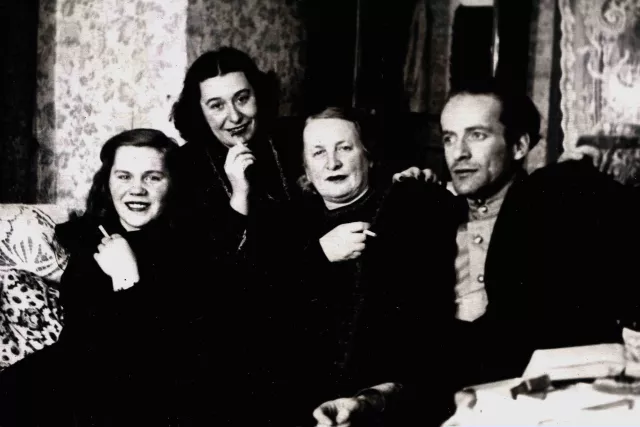Solomon Epstein, his mother and friends
This photograph taken in 1950 shows my mother, her friends and me. Here I’ll tell you about our life after the end of the war.
So, the war was finished. I (a front-line soldier with awards and 10 classes of school education) had to think about demobilization and further study. I returned to Leningrad.
My Mom had returned from evacuation a little earlier and waited for me in our apartment. Father survived the war, but did not return home: he married another woman. Father died in Moscow in 1970s.
I have told you already that I was so much eager to study that submitted my documents to 3 higher educational institutions at the same time. I tried to understand myself. But by that time my teacher Konstantin Kardabovsky returned from evacuation and convinced me to enter the Academy of Arts.
It seemed to me that I was able to better all entrants, but it appeared that people did not like arrogant men. They flunked me in my entrance examinations. Then I entered the 3rd course of the high art school. I studied there during a year, and then entered the Academy of Arts (the department of painting) trouble-free.
I studied in the workshop of Professor Oreshnikov (a remarkable teacher and a top-class professional artist). After graduation from the Academy, I started working at the USSR Union of Artists. [The USSR Union of Artists was founded in 1957.]
There every artist had got an agent (art critics), who used to find orders for the artists. We performed those orders and earned money for living. There was a lot of interesting work.
One of orders came from the state farm where I was in evacuation. There was a fur farm. I painted a picture for them and sent a letter describing my life there during evacuation. We painted different pictures.
For example, one of them was devoted to a working day on a cattle-breeding farm. I remember that I had to go to Kirov to perform that order. Another one was to paint a working day in the railway depot in Kotlas. I went to Kotlas, met with the local Communist Party committee secretary, and asked about the purpose of the future picture.
He answered that it was meant for the House of Culture where workers usually spent their spare time. I asked the secretary whether it was reasonable to show workers their working day when they wanted to relax.
He hesitated a minute, but said 'Paint a working day: we would feel great security.' You see, I had got a lot of orders. But usually I managed to find some time to paint for myself, so to say for my private satisfaction.
I lived with my Mom. She was often sick, worked in some workmen's cooperative association and earned just a dab of money. She died in 1956.
Rather long time we lived in a two-room apartment in Zhukovskogo Street. Both rooms were dim: the wall of the opposite building was 2 meters and 6 centimeters far from our windows. And according to sanitary norms it was necessary to have not more than 2 meters for improvement of living conditions.
Members of the Union of Artists put their artists on their own waiting list. I visited the secretary of the regional Communist Party Committee and he helped me. I was suggested to occupy a workshop and an apartment of an artist who had left for Israel. Giving me the voucher, a local official told me with hatred, 'Is this apartment a runway for flying away to Israel?'
We used to spend summer vacations out of the city. Sometimes we rented dacha, sometimes lived at our friends.













